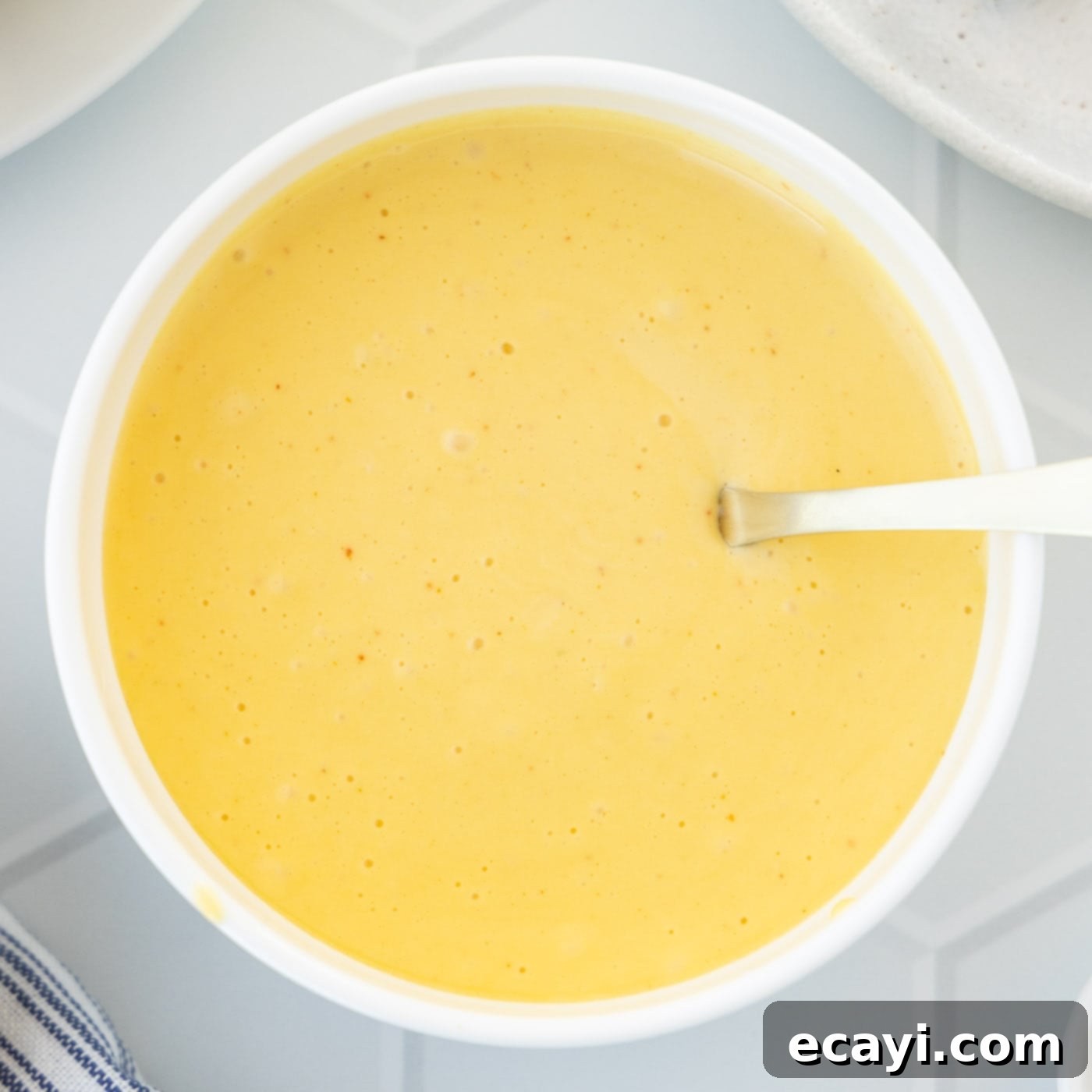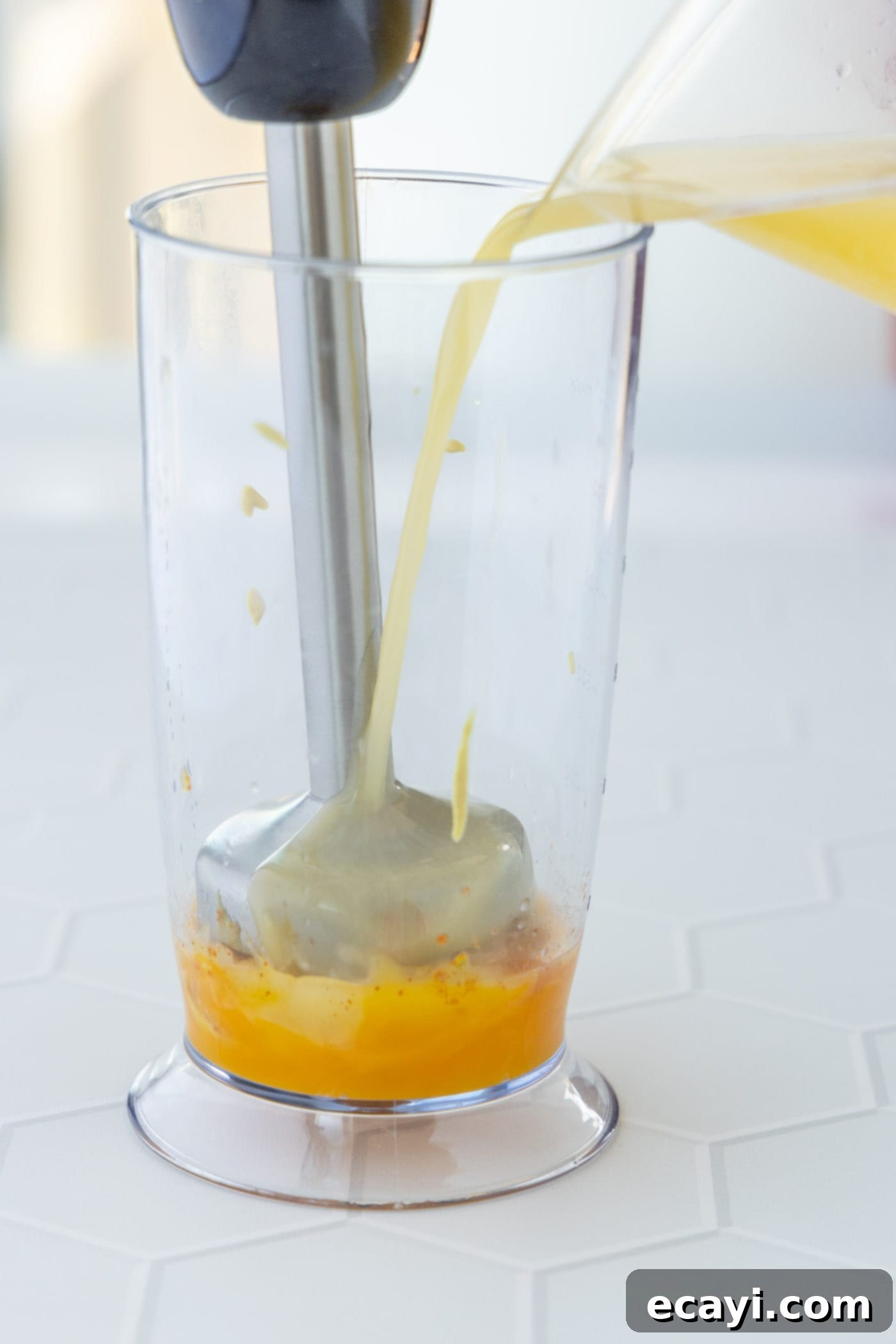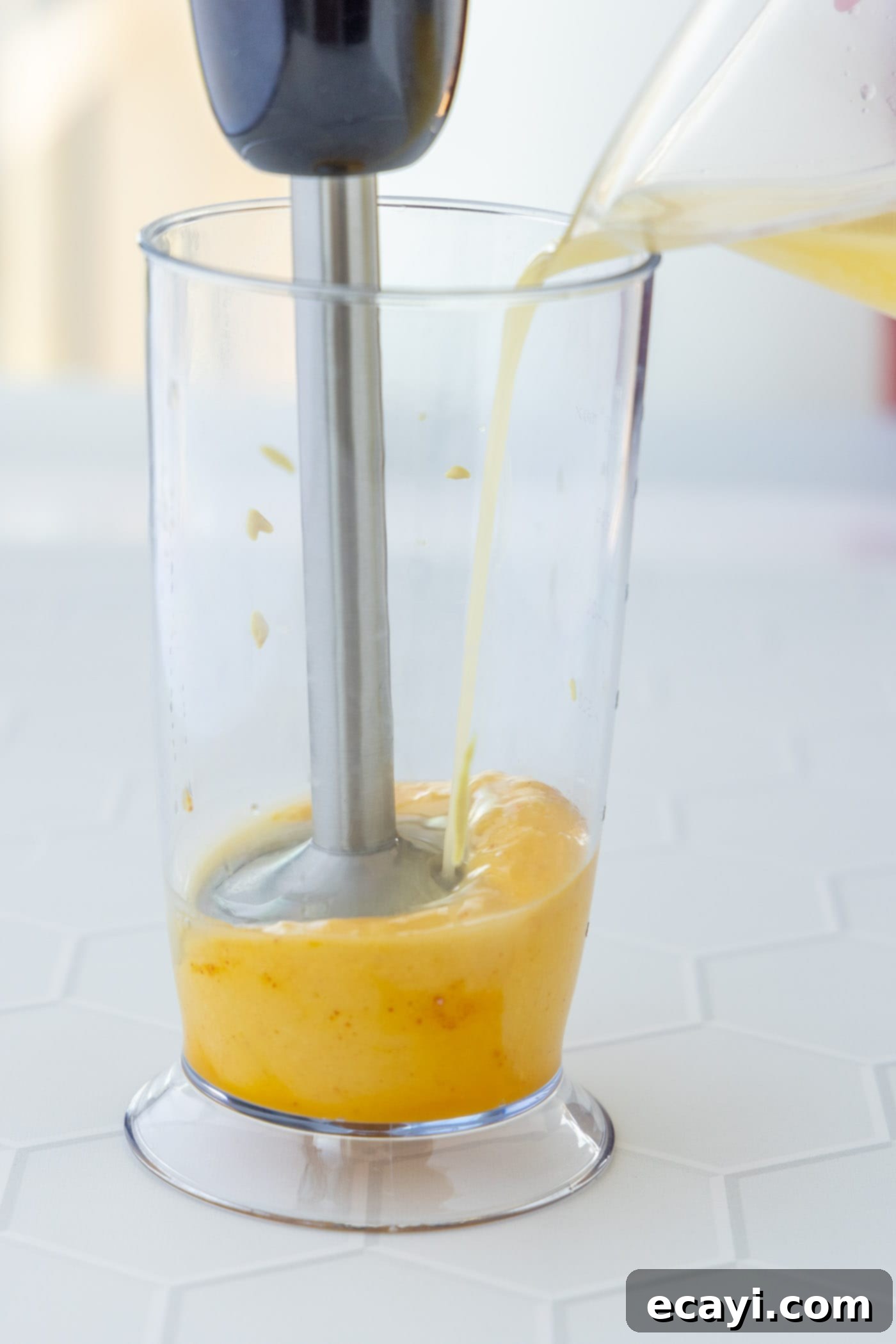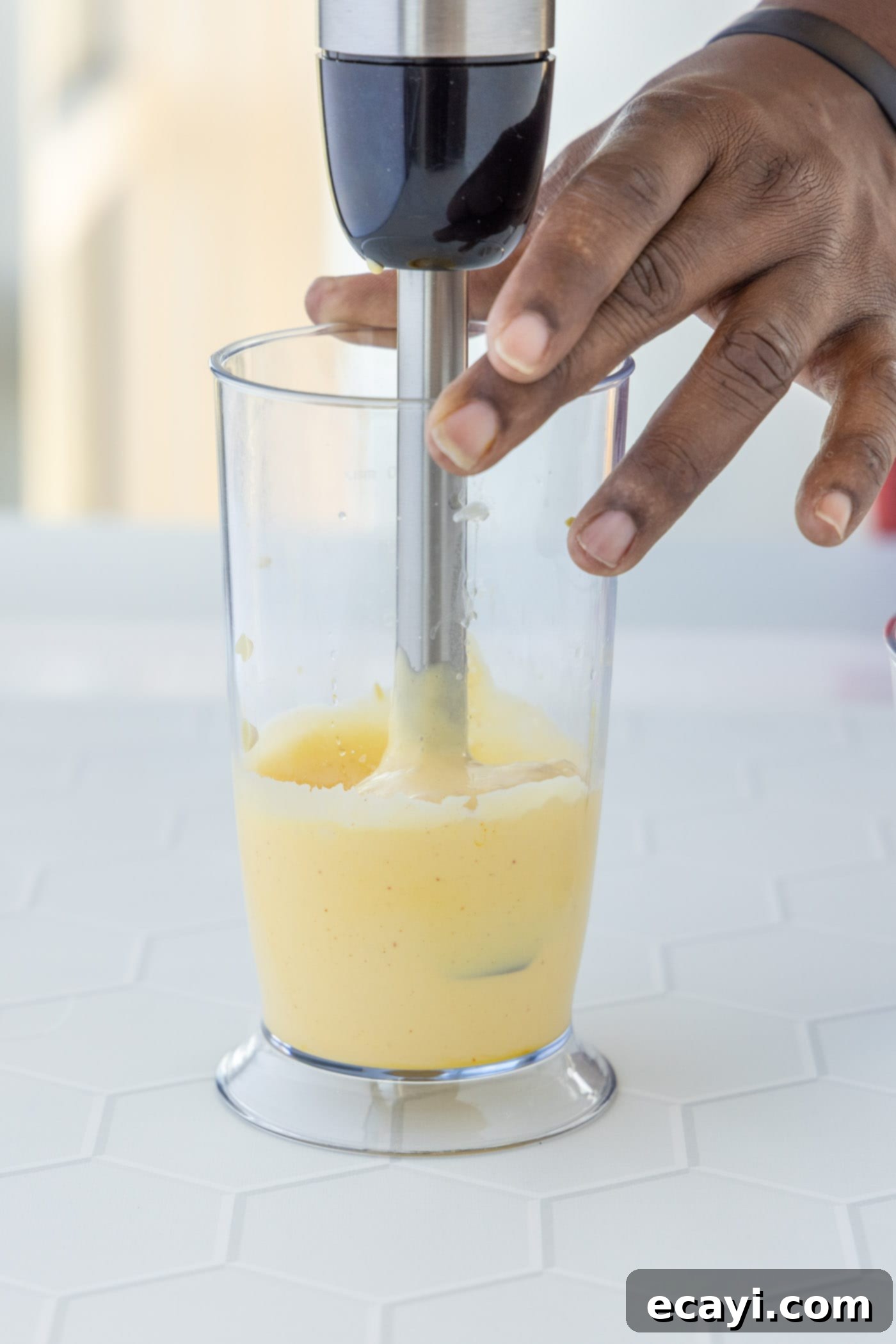Quick & Easy 5-Minute Hollandaise Sauce: The Ultimate Immersion Blender Recipe for Creamy Perfection
Mastering a classic sauce like Hollandaise might seem intimidating, often conjuring images of fussy double boilers and endless whisking. But what if we told you that velvety, rich, and utterly delicious Hollandaise sauce could be yours in just 5 minutes, using only 6 simple ingredients and the magic of an immersion blender? This incredibly quick and creamy classic sauce truly comes together in a snap, transforming everyday meals into extraordinary culinary experiences.
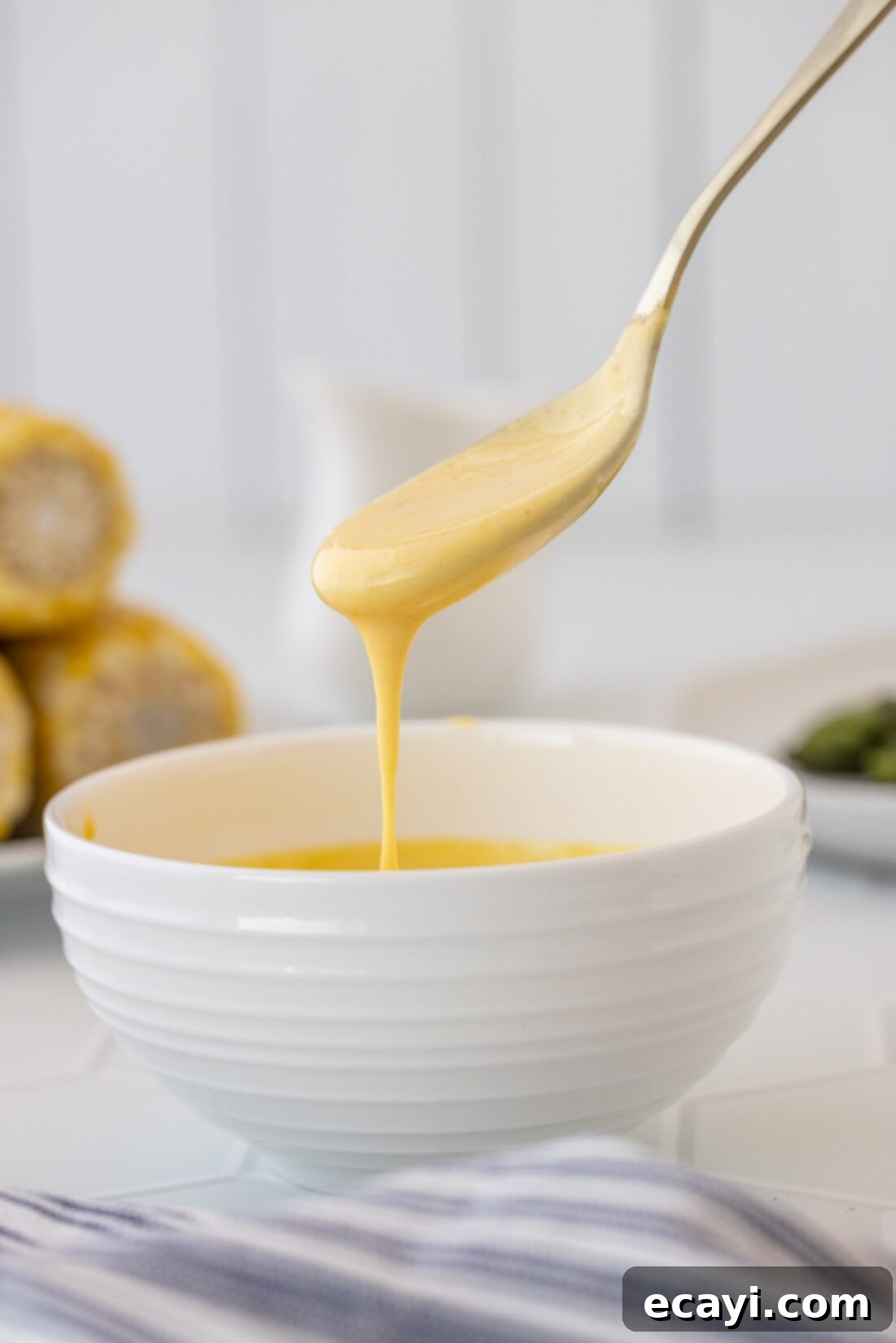
Why This Immersion Blender Hollandaise Recipe Works Wonders
While Hollandaise sauce is most famously recognized as the crowning glory of Eggs Benedict, its creamy, tangy, and rich profile makes it incredibly versatile. It’s a culinary chameleon, elevating a vast array of dishes from indulgent breakfasts and leisurely brunches to quick lunches and elegant dinners. Forget about the days when Hollandaise was reserved only for professional kitchens or special occasions; this recipe brings the gourmet right to your countertop.
The secret to a truly outstanding Hollandaise sauce often comes down to the butter. Traditional methods can be finicky, demanding specific butter temperatures and meticulous whisking to achieve the perfect emulsion. However, this immersion blender method, inspired by the wisdom of chefs like Antoine, simplifies the process dramatically. The key isn’t necessarily scorching hot butter, but rather the controlled, slow drizzling of melted butter into the other ingredients while continuously blending. This precise technique, effortlessly managed by an immersion blender, ensures a stable and velvety emulsion every single time, practically eliminating the risk of a “broken” sauce.
Beyond the foolproof technique, the brilliance of this recipe lies in its simplicity. You’ll only need 6 common ingredients: fresh egg yolks, vibrant lemon juice, perfectly melted unsalted butter, and a trio of flavor enhancers – zesty Dijon mustard, a pinch of salt, and a touch of cayenne pepper for a subtle kick. Each ingredient plays a crucial role in building the sauce’s characteristic flavor and luxurious texture, proving that extraordinary results don’t require an extensive shopping list or complex steps. This recipe truly democratizes Hollandaise, making it accessible to home cooks of all skill levels.
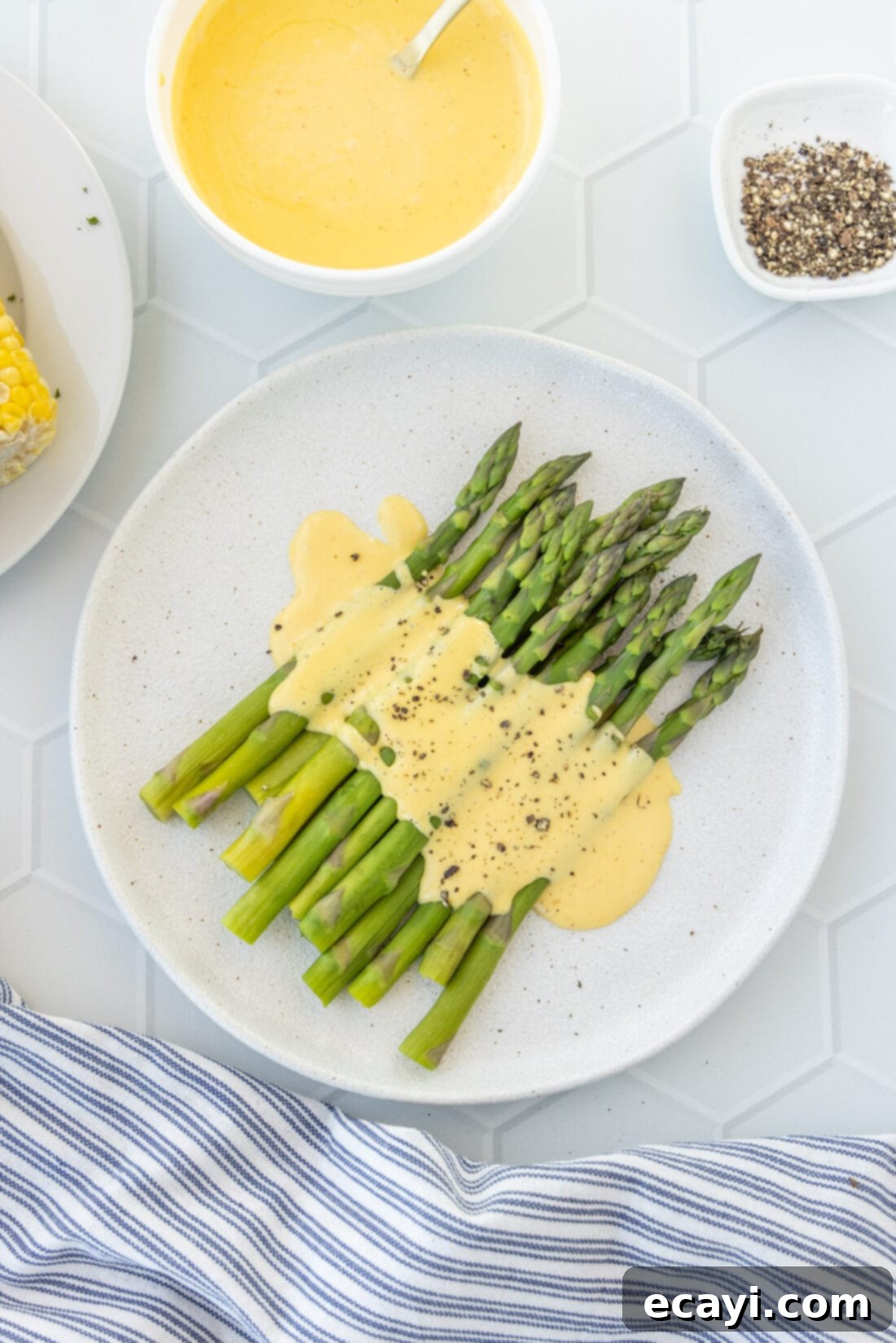
Essential Ingredients for Your Perfect Hollandaise Sauce
Before you begin, gather these few, but mighty, ingredients. You can find all precise measurements and detailed instructions in the printable recipe card at the conclusion of this article.
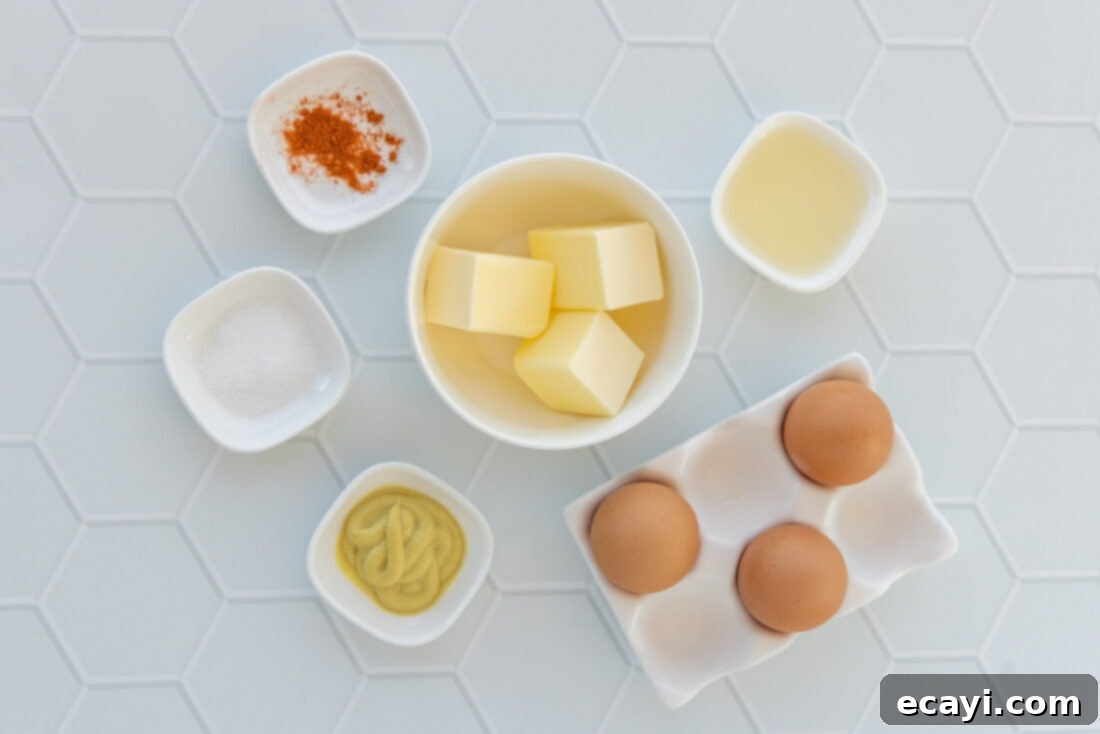
Ingredient Insights and Smart Substitution Suggestions
Each component of this Hollandaise recipe contributes to its signature flavor and texture. Understanding their roles and knowing potential substitutions can help you achieve the best results or adapt the sauce to your pantry.
- BUTTER: We highly recommend using unsalted butter. This allows you to control the overall saltiness of the sauce precisely. While many traditional recipes insist on very hot melted butter, the real trick with the immersion blender method is not the heat, but rather the slow and steady drizzling. Ensure your butter is fully melted, but it doesn’t need to be piping hot – a warm, liquid state is perfect. Drizzle it in slowly as the immersion blender runs to create a stable emulsion and prevent separation. For an even richer, nuttier flavor, you could try browning a portion of your butter before melting it fully and cooling it slightly.
- EGG YOLKS: These are the backbone of your Hollandaise, providing richness, color, and, most importantly, the emulsifying agents (lecithin) that bind the sauce together. We use large egg yolks. If you’re concerned about consuming raw eggs, consider using pasteurized egg yolks, which are widely available in many grocery stores. Always ensure your eggs are fresh for optimal flavor and performance.
- LEMON JUICE: The bright acidity of fresh lemon juice is non-negotiable for authentic Hollandaise. It cuts through the richness of the butter and egg yolks, adding a vital tangy counterpoint. While the recipe calls for a small amount, the difference between freshly squeezed and pre-bottled lemon juice is immense. Fresh juice provides a brighter, more natural citrus flavor that bottled varieties simply cannot replicate. You’ll typically only need one lemon to yield the required amount for this recipe.
- DIJON MUSTARD: Added for its distinctive pungent and slightly tangy flavor, Dijon mustard also acts as a secondary emulsifier, helping to stabilize the sauce. We prefer its sophisticated tang, but in a pinch, you can substitute yellow mustard at a 1:1 ratio. Be aware that yellow mustard will impart a slightly different, milder flavor profile. For those who enjoy a subtle warmth, a tiny dash of dry mustard powder can also be used.
- SALT & CAYENNE PEPPER: Salt is essential for seasoning, balancing all the flavors, and making the sauce pop. Cayenne pepper adds a very subtle warmth and depth, without making the sauce spicy. It’s a classic addition that rounds out the flavor profile beautifully. Feel free to adjust the amount of cayenne to your preference, or omit it if you prefer no heat at all. A pinch of white pepper can also be used for a slightly different aromatic note.
How to Effortlessly Make Hollandaise Sauce with an Immersion Blender
These step-by-step photos and detailed instructions are designed to help you visualize each stage of making this incredibly easy Hollandaise sauce. For a quick jump to the printable version of this recipe, complete with precise measurements and comprehensive instructions, simply Jump to Recipe at the bottom of the post.
-
Begin by adding all your ingredients, except the melted butter, into the tall, narrow cup that typically accompanies your immersion blender. This includes the egg yolks, lemon juice, Dijon mustard, salt, and cayenne pepper. Insert your immersion blender into the cup, ensuring the blade is fully submerged. Pulse and blend these ingredients until they are thoroughly combined and slightly frothy, creating a smooth base for your sauce.


-
With the immersion blender still running continuously at a steady speed, slowly begin to pour the melted unsalted butter into the cup in a thin, steady stream. It’s crucial to add the butter gradually – think of it as a gentle drizzle rather than a pour. The blender will work its magic, emulsifying the butter into the egg yolk mixture. Continue blending until the sauce transforms into a pale yellow, thick, and wonderfully creamy consistency. The entire process of adding butter and blending should take no more than 1-2 minutes.

Frequently Asked Questions & Expert Tips for Perfect Hollandaise
Homemade Hollandaise sauce is undeniably at its peak when served immediately. Its delicate emulsion is best enjoyed fresh. However, if you do find yourself with leftovers, you can store the sauce in an airtight container in the refrigerator for up to 2-3 days. Beyond this timeframe, you significantly increase the risk of the sauce separating, losing its creamy texture and fresh flavor. For best results, press plastic wrap directly onto the surface of the sauce before sealing the container to prevent a skin from forming and to reduce oxidation.
Reheating Hollandaise can be tricky, as high heat is the enemy of its delicate emulsion. To successfully reheat chilled Hollandaise, transfer it to a small saucepan and warm it over very low-medium heat. Stir constantly and gently with a whisk until it’s just warmed through and returns to a smooth consistency. Avoid boiling or vigorous simmering, as this will almost certainly cause the sauce to separate or curdle. If it seems too thick, you can whisk in a tiny amount of warm water or lemon juice, one teaspoon at a time, to reach your desired consistency.
Absolutely! If an immersion blender isn’t handy, a regular blender will work perfectly well. The principles remain the same: combine all ingredients except the butter in the blender. Blend them thoroughly, then with the blender running on a low speed, slowly stream in the melted butter through the opening in the lid. Continue blending until the sauce emulsifies and thickens to your liking. The key is the slow addition of butter to allow for proper emulsification.
Don’t panic! A broken Hollandaise is often salvageable. There are a few methods to rescue it:
- Ice Cube Method: Place one ice cube and a tablespoon of water into a clean bowl. Whisk vigorously until the ice cube melts and the mixture is cold. Slowly whisk in the broken sauce, a tablespoon at a time, until it re-emulsifies.
- Fresh Yolk Method: In a separate clean bowl, whisk one fresh egg yolk with a teaspoon of warm water or lemon juice until light. Gradually whisk the broken Hollandaise sauce into this fresh yolk mixture, slowly incorporating it until it comes back together.
- Hot Water Method: For a slightly broken sauce, simply add a teaspoon or two of very hot (but not boiling) water and whisk vigorously. This can sometimes bring it back.
The most common causes of separation are adding the butter too quickly, the sauce getting too hot, or getting too cold and then reheating improperly.
Using unsalted butter gives you precise control over the final seasoning of your Hollandaise. Salted butter can vary in its salt content, making it difficult to achieve the perfect balance. If you only have salted butter, you can use it, but be sure to reduce or even omit the additional salt called for in the recipe and taste before adding more. You might also want to rinse salted butter briefly in cold water and pat it dry, though this is less common for Hollandaise.
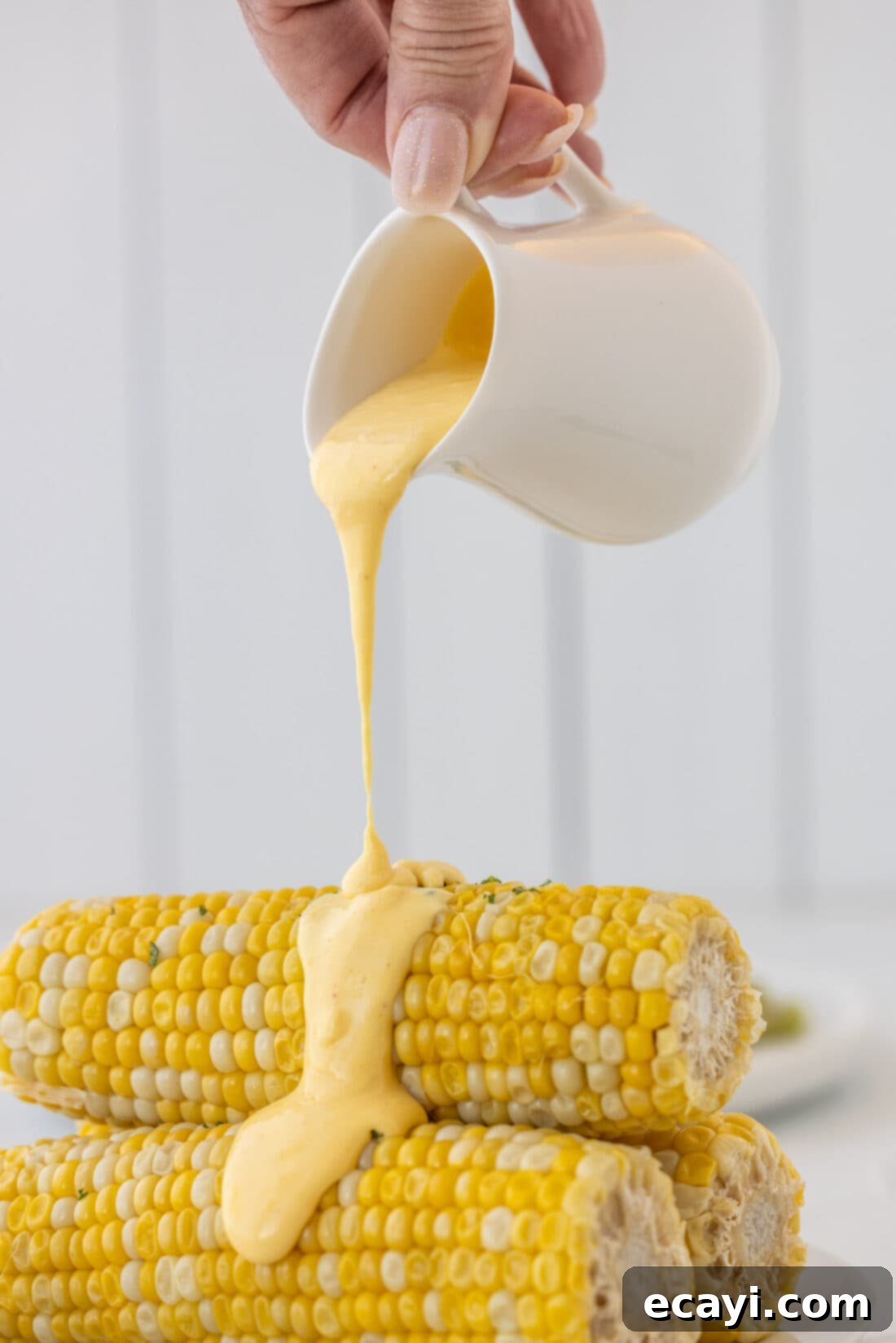
Delicious Serving Suggestions for Your Homemade Hollandaise
Once you’ve experienced the ease and incredible flavor of homemade Hollandaise, you’ll want to drizzle it over everything! This versatile sauce pairs beautifully with a wide variety of dishes:
- Classic Pairings: Of course, Eggs Benedict is the quintessential choice. But also consider it over perfectly roasted asparagus, steamed broccoli, tender green beans, or sweet corn.
- Seafood Delights: Hollandaise is a match made in heaven for seafood. Drizzle it generously over poached salmon, grilled halibut, pan-seared scallops, or delicate crab cakes. It also complements shrimp and lobster wonderfully.
- Beyond Breakfast: Don’t limit Hollandaise to just the morning meal. Try it with pan-fried chicken breasts, a perfectly cooked steak, or even as a decadent topping for baked potatoes.
- Vegetable Enhancement: Any steamed or roasted vegetable can be transformed with a dollop of Hollandaise. Think Brussels sprouts, artichokes, or even cauliflower.
For the absolute best texture and flavor, serve your Hollandaise sauce immediately after preparing it. Its warmth and creaminess are simply irresistible.
Explore More Delicious Sauce Recipes
If you’ve enjoyed making this easy Hollandaise, you might love exploring other homemade sauces to elevate your cooking. A great sauce can truly make a meal!
- Homemade French Fry Sauce
- Rich Penne Bolognese Sauce
- Zesty Alabama White Sauce
- Fragrant Rosemary Cream Sauce
- Authentic Homemade Enchilada Sauce
I absolutely adore cooking and baking, and there’s nothing I love more than sharing my kitchen adventures and successful recipes with all of you! Remembering to check back for new culinary inspiration every day can be a challenge, which is why I offer a convenient newsletter delivering a fresh recipe directly to your inbox each time I post. Simply subscribe today and start receiving your free daily recipes, making it easier than ever to discover your next favorite dish!
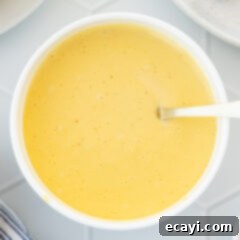
Hollandaise Sauce
IMPORTANT – Don’t forget to scroll up to the blog post for helpful Frequently Asked Questions and expert tips!
Print It
Pin It
Rate It
Save It
Saved!
Course:
Condiments
Cuisine:
French
3
servings
5 minutes
330
Amanda Davis
Ingredients
-
3 large egg yolks -
1 Tablespoon lemon juice -
1 Tablespoon Dijon mustard -
¼ teaspoon salt -
1 pinch cayenne pepper -
½ cup unsalted butter melted
Things You’ll Need
-
immersion blender or regular blender
Before You Begin
- While some older recipes may emphasize piping hot melted butter, the real secret to success with this immersion blender method, as taught by Chef Antoine, is the slow, steady drizzle of the butter as you blend. This careful technique, rather than extreme heat, is what creates a perfect emulsion and prevents your Hollandaise from breaking.
- For the freshest and best flavor, homemade Hollandaise sauce is always best enjoyed immediately after preparation. If you happen to have leftovers, they can be stored in an airtight container in the refrigerator for 2-3 days. However, be aware that storing it longer than this increases the chance of the sauce separating and losing its ideal texture.
- To help prevent separation, ensure all your initial ingredients (egg yolks, lemon juice, mustard, etc.) are at room temperature before blending. This helps them emulsify more smoothly with the butter.
Instructions
-
To the immersion blender cup, add all ingredients EXCEPT the melted butter: egg yolks, lemon juice, Dijon mustard, salt, and cayenne pepper. Insert the immersion blender and blend thoroughly until the mixture is well combined and slightly frothy.
-
With the immersion blender running on a steady speed, slowly and gradually drizzle the melted butter into the cup. Continue blending as you add the butter until the sauce becomes pale yellow, thick, and perfectly creamy. Serve immediately.
Nutrition
Serving:
1serving (1/4 cup)
|
Calories:
330cal
|
Carbohydrates:
1g
|
Protein:
3g
|
Fat:
35g
|
Saturated Fat:
21g
|
Polyunsaturated Fat:
2g
|
Monounsaturated Fat:
10g
|
Trans Fat:
1g
|
Cholesterol:
265mg
|
Sodium:
261mg
|
Potassium:
41mg
|
Fiber:
0.2g
|
Sugar:
0.3g
|
Vitamin A:
1208IU
|
Vitamin C:
2mg
|
Calcium:
35mg
|
Iron:
1mg
Tried this Recipe? Pin it for Later!
Follow on Pinterest @AmandasCookin or tag #AmandasCookin!
The recipes on this blog are meticulously tested using a conventional gas oven and a gas stovetop. Please be aware that individual ovens, especially older models, can exhibit inconsistencies in cooking and baking temperatures. We highly recommend using an inexpensive oven thermometer to ensure your oven is consistently heating to the correct temperature. If you opt for a toaster oven or countertop oven, remember that they may not distribute heat as evenly as a full-sized conventional oven, and you might need to adjust your cooking and baking times accordingly. For recipes involving pressure cookers, air fryers, slow cookers, or other specific appliances, a link to the models we utilize is provided within each respective recipe. For baking recipes where measurements are given by weight, it’s important to note that substituting cup measurements may yield different results, and we cannot guarantee success with this alternative method.
